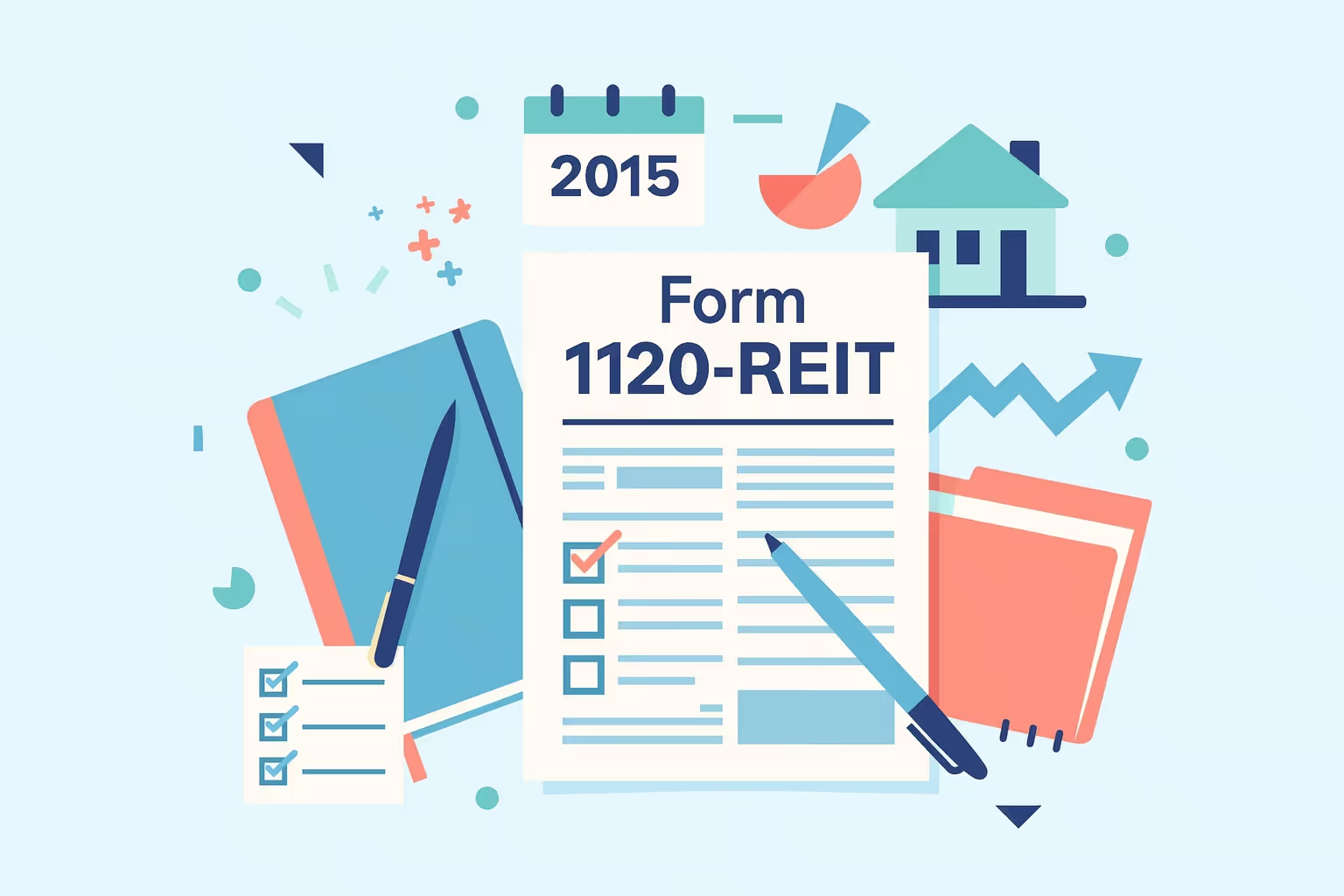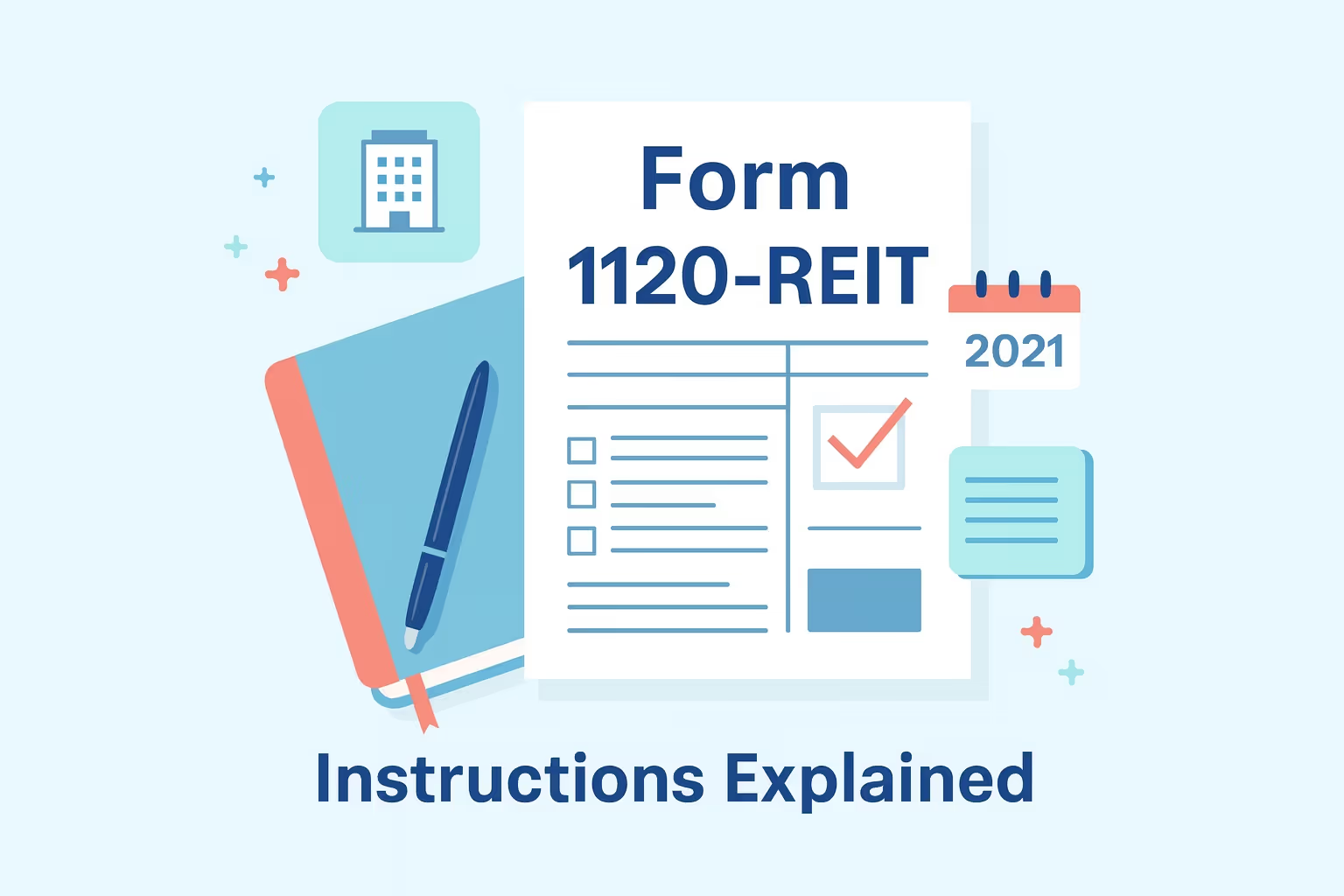Form 1120-REIT 2024 Instructions: Essential Filing Guide
Form 1120-REIT is the annual federal income tax return for Real Estate Investment Trusts (REITs). Qualifying corporations, trusts, and associations each year use this form to report their taxable income, deductions, and capital gains. Filing accurately ensures your organization maintains its official REIT status under IRS rules. Whether your REIT holds office buildings, mortgage assets, or mixed real estate investments, this return is the foundation of your federal corporate income tax obligations.
The IRS requires every active or dormant REIT to file Form 1120-REIT, even if it reports no yearly income or activity. Completing this income tax return correctly helps document dividends paid to shareholders and verify compliance with ownership, income, and asset tests. REITs that fail to file risk losing favorable tax treatment and may face costly penalties.
For the 2024 tax year, filers should note several significant changes. The IRS increased penalties for late submissions and expanded electronic filing rules. All federal tax deposits must be made electronically through the Electronic Federal Tax Payment System (EFTPS). Always review the official IRS Form 1120-REIT 2024 instructions and consult a qualified tax professional to ensure accurate reporting and full compliance.
Understanding Form 1120-REIT
Form 1120-REIT is Real Estate Investment Trusts's official income tax return (REITs). It reports a REIT’s taxable income, deductions, and capital gains to determine any tax owed or credits due. This form also documents compliance with REIT qualification tests and allows entities to claim the dividends-paid deduction. Filing ensures that income distributed to shareholders is appropriately accounted for under federal corporate income tax rules.
Compared with standard corporate tax forms such as Form 1120 or Form 1120-S, Form 1120-REIT includes sections specific to REIT operations. These include tests for income from real estate investments, ownership requirements, and the treatment of ordinary income and dividends. In essence, it reflects the hybrid nature of REITs, which combine features of corporations and mutual funds that invest primarily in real estate or mortgages.
Who Must File Form 1120-REIT
Entities that meet the following conditions are required to file:
- Entity Structure: The organization must be a corporation, trust, or association taxable as a domestic corporation.
- Election: The entity must have elected to be treated as a REIT under Internal Revenue Code sections 856–860.
- Ongoing Status: The REIT election must remain valid and not revoked or terminated.
- Activity Level: Even if the REIT had no income or activity during the tax year, it must still file to maintain its status.
Filing confirms the entity’s continued compliance with REIT standards, including shareholder diversification, asset composition, and income source requirements.
Why Filing Is Mandatory
Annual filing is required whether or not a REIT earns taxable income. The IRS uses the return to ensure the trust meets REIT qualification standards, such as the 75% and 95% gross income tests. Failure to file can lead to penalties, revocation of REIT status, or reclassification as a regular corporation, resulting in double taxation on corporate and shareholder income.
Timely and accurate filing protects investors by maintaining the REIT’s transparency and accountability. For complete details and the latest filing requirements, visit the official IRS Form 1120-REIT.
What’s New for Tax Year 2024
The IRS has made several key updates to Form 1120-REIT filing procedures for the 2024 tax year. These changes affect how Real Estate Investment Trusts (REITs) report income, file returns, and submit payments.
- Increased Late-Filing Penalties: The minimum penalty for returns filed more than 60 days late has increased to the smaller of the taxes due or $510. This update applies to returns due in 2025 and reinforces the importance of timely filing.
- Expanded Electronic Filing Rules: Corporations and trusts that file 10 or more returns during the calendar year must now file electronically. This requirement covers Form 1120-REIT and ensures greater accuracy and faster IRS processing.
- Electronic Payment Mandate: All REITs must make federal tax deposits through the Electronic Federal Tax Payment System (EFTPS). Paper checks and cash deposits are no longer accepted.
- Updated Forms and Schedules: The IRS revised several related forms, including Schedule M-3, Form 8996, and other supporting schedules. These updates align with current reporting standards for capital gains, deductions, and ordinary income.
Review the official IRS instructions for Form 1120-REIT for complete details on these updates.
Step-by-Step Instructions for Completing Form 1120-REIT
Completing Form 1120-REIT requires careful organization, accurate reporting, and compliance with IRS rules. The following steps outline preparing each section correctly while minimizing filing errors and potential penalties.
Step 1 – Gather Required Information
Preparing your REIT’s income tax return begins with collecting accurate and complete records. Having all relevant documents ready ensures that every entry on the form is supported and consistent with your books and financial statements.
You should gather:
- Basic entity details: Confirm your REIT’s legal name, mailing address, Employer Identification Number (EIN), and tax year dates. These details must match prior filings exactly.
- Prior-year tax return: Review your last Form 1120-REIT to identify carryovers, reference data, and any changes in ownership or accounting methods.
- Income documentation: Compile all real estate income records, including rental agreements, mortgage interest, and other ordinary income sources.
- Capital gains and investment records: Prepare documentation for property or security sales showing cost basis, sale price, and holding periods for Schedule D reporting.
- Asset and depreciation schedules: Maintain updated listings for all real estate investments, improvements, and equipment, with detailed depreciation records.
- Payroll and compensation data: Gather records of wages, officer compensation, and related employment tax payments.
- Dividend distribution reports: Include statements showing total dividends declared and paid to shareholders during the tax year.
- Banking and payment confirmations: Keep evidence of federal EFTPS payments, quarterly estimates, and refunds applied from prior years.
- Corporate documentation: Retain board resolutions authorizing distributions, ownership changes, and significant transactions.
- Power of attorney: If a tax professional will sign the return, ensure a valid authorization form is on file.
Having these records in order before beginning the return reduces preparation time, improves accuracy, and helps prevent costly IRS correspondence.
Step 2 – Complete the Form Header
The header identifies your REIT and its filing status. Complete it using the exact legal and identification details used in prior years.
- Enter the REIT’s legal name, address, and EIN exactly as registered.
- Check the appropriate box if this is an initial, final, or amended return.
- State whether the return is for a calendar or a fiscal year, and ensure the period matches your accounting records.
- Include the name and title of the officer authorized to sign the return.
Step 3 – Report Income Accurately
To calculate taxable income, each income type must be classified correctly. Misreporting can affect qualification tests or trigger an audit.
- Rental income: Report gross rents from real property the REIT owns, including adjustments for abatements or incentives.
- Interest income: Record mortgage interest and other portfolio interest as ordinary income.
- Dividends: Include dividends from other corporations or REITs.
- Capital gains: Report all property or security sales using Schedule D, and attach Form 8949 if needed.
- Foreclosure property income: Calculate separately since this income may be taxed at regular corporate rates.
- Prohibited transactions: Identify property sales that could trigger a 100% tax and note the qualifying safe harbor rules.
Step 4 – Calculate Deductions
Deductions lower taxable income and must be supported by reliable documentation.
- Dividends-paid deduction (Schedule A): Report all dividends paid or declared.
- Compensation and wages: Deduct officer and staff wages that are ordinary and necessary for operations.
- Taxes and interest: Include property taxes, business licenses, and loan interest directly tied to REIT activities.
- Repairs and maintenance: Deduct costs for maintaining investment properties, not capital improvements.
- Depreciation: Record allowable depreciation for buildings and improvements under current IRS methods.
- Charitable contributions: Report qualified gifts, ensuring proper receipts and documentation are retained.
Step 5 – Complete Required Schedules
Supporting schedules must be filed correctly to ensure complete processing by the IRS.
- Schedule A – Dividends Paid Deduction: Summarize shareholder distributions and reconcile totals with payment records.
- Schedule J – Tax Computation: Calculate tax liability after credits, excise tax, and prior payments.
- Schedule K – Other Information: Provide details about ownership, foreign operations, and compliance questions.
- Schedule L – Balance Sheets per Books: Report beginning and ending balances consistent with your trial balance.
- Schedule M-1 or M-3 – Book-to-Tax Reconciliation: Use Schedule M-3 if total assets are $10 million or more or if a consolidated return is filed.
Attach all required forms, including Schedule D, Form 8996, and any international schedules, in the IRS’s prescribed order. Conduct a final review for signatures, totals, and consistency before submission. Completing Form 1120-REIT helps your organization maintain REIT status, avoid penalties, and fully comply with federal tax obligations.
Filing Methods and Deadlines
Filing Form 1120-REIT correctly and on time is essential for maintaining compliance and protecting your REIT’s tax status. The IRS offers electronic and paper filing options, though most entities must now file electronically.
Electronic Filing (E-File)
Electronic filing is the preferred and, for many REITs, the required method. If your organization files ten or more federal returns in a calendar year, you must e-file Form 1120-REIT. This rule applies to equity REITs that own and operate properties and mortgage REITs that earn income from mortgage payments and interest.
E-filing provides several benefits:
- Quick processing: The IRS receives electronic submissions right away.
- Fewer errors: Built-in validation features help prevent data entry mistakes.
- Confirmation of receipt: The filer receives digital proof of submission.
- Convenience: Attach schedules, other forms, and supporting documents in one secure upload.
Before filing, review all data for consistency with your books, retained earnings, and prior-year filings. Ensure that information on REIT dividends, ordinary dividends, and capital gains taxes matches what was distributed to shareholders.
Paper Filing (If Allowed)
Paper filing is permitted only for entities not required to e-file. If your REIT qualifies, use the current-year version of the form, attach all the necessary schedules, and sign the return before mailing. Mailing addresses vary by state and total assets, so verify the correct location using current IRS instructions.
Filing Deadlines and Extensions
The due date for most REITs is the 15th day of the fourth month after the end of the tax year, typically April 15 for calendar-year filers. Fiscal-year REITs ending June 30 must file by the 15th day of the third month after year-end. Extensions may be requested using Form 7004, but do not extend the time to pay taxes owed.
Timely filing ensures individual investors—including those holding REIT shares in traditional IRAs or retirement accounts—receive accurate dividend information. Consistent compliance protects your REIT’s standing and preserves its earnings for future retirement plans, as well as long-term investors holding REITs for income stability.
Payment Instructions and Estimated Tax Requirements
Timely payment is vital to filing Form 1120-REIT. The IRS requires all Real Estate Investment Trusts to make payments electronically to reduce errors and improve processing speed. The following sections explain how to correctly submit payments and meet estimated tax obligations.
Electronic Payment Options
All REITs must use the Electronic Federal Tax Payment System (EFTPS) to make deposits. The system allows payments to be scheduled in advance, helping filers avoid missed deadlines.
- Electronic Federal Tax Payment System (EFTPS): Payments are made directly from your business bank account, and the IRS provides confirmation once the transaction clears. This ensures your money is credited accurately and traceably.
- Same-day wire transfers: REITs may also use a same-day wire transfer through their bank or financial institution. Transitions must be initiated by 2:00 p.m. Eastern Time to count as timely.
- Example: If your REIT’s tax year ends on December 31, and the payment is due April 15, you must submit the wire transfer before the cutoff time that day.
These electronic methods protect against delays, ensure transparency, and provide reliable proof of payment.
Payment Due Dates
Payments are generally due on the 15th day of the fourth month after the end of the tax year.
- Calendar-year REITs: The payment is due April 15.
- Fiscal-year REITs: If the year ends on June 30, payment is due by September 15.
- Extensions: Filing Form 7004 grants extra time to file, but does not extend the payment due date.
Failing to meet these deadlines can result in penalties or interest on unpaid balances.
Estimated Tax Payments
REITs expecting to owe $500 or more in tax are subject to quarterly estimated payments. These installments help spread tax liability evenly throughout the year and prevent large end-of-year payments.
Quarterly due dates typically fall on:
- April 15
- June 15
- September 15
- December 15
To avoid penalties, each payment must equal at least 90% of the current year’s tax or 100% of the prior year’s liability.
When calculating estimated payments, include:
- Include profits from rental and investment activities: These earnings represent a significant portion of your REIT’s taxable income and must be reflected in estimated payments.
- Add income from stock sales, property transactions, and bond interest: These sources increase total taxable income and should be reported accurately each quarter.
- Factor in foreign income and exchange transactions: These activities can affect taxable gains and must be included when determining estimated tax amounts.
- Consider operating expenses: Expenses that reduce cash flow can influence the timing and amount of estimated payments.
Maintaining organized records ensures accurate and properly documented payments. Following these procedures helps your REIT stay compliant and avoid unnecessary penalties or payment disputes with the IRS.
Common Filing Mistakes and How to Avoid Them
Filing Form 1120-REIT requires precision and careful review. Even small mistakes can delay processing or lead to penalties that affect your REIT’s compliance status. The following are common filing errors and ways to prevent them:
- Using an incorrect EIN or tax year: Always verify that your Employer Identification Number and reporting period match previous filings and financial statements.
- Leaving required fields blank: Every applicable line on the form must be completed, even if the amount is zero. Avoid writing “See attached” in place of a value or explanation.
- Omitting schedules or other required forms: Ensure that all schedules—especially Schedule A, Schedule J, and Schedule D—are appropriately attached.
- Reporting errors in income or deductions: Misstating rental income, capital gains, or dividends can cause discrepancies between the return and your accounting records.
- Late or unsigned returns: Submitting the form without an authorized signature or after the filing deadline may result in penalties or loss of REIT status.
- Inconsistent documentation: Keep detailed records of expenses, payments, and shareholder distributions to support every entry.
A final accuracy review before submission can prevent most errors. Cross-checking figures and attachments helps ensure your REIT’s return is complete, compliant, and processed without delays.
Filing for Dormant or Zero-Activity REITs
Even if your Real Estate Investment Trust (REIT) has no income or operational activity during the year, you must still file Form 1120-REIT to maintain your REIT status. A “dormant” REIT remains subject to annual filing requirements as long as its election to be treated as a REIT has not been revoked or terminated.
- Annual filing remains mandatory: The IRS requires a yearly return to confirm that the REIT meets qualification standards, even with no income or distributions.
- Report zeros when appropriate: Enter zeros in income, deduction, and tax sections to reflect inactivity, but still complete every applicable field on the form.
- Attach required schedules: Even if the values are minimal or zero, include Schedule A, Schedule J, and any other supporting schedules.
- Maintain shareholder and asset compliance: The REIT must continue to satisfy the 100-shareholder rule, ownership limits, and asset composition tests.
- Keep accurate records: Maintain documentation of shareholder lists, ownership changes, and any remaining assets for audit purposes.
Filing consistently—even with zero activity—prevents the loss of REIT status, ensures transparency, and positions the organization for smooth reactivation when operations resume.
First-Time REIT Filer Guidance
Filing Form 1120-REIT for the first time can be complex, especially for organizations newly qualifying as Real Estate Investment Trusts. Proper preparation and compliance with IRS requirements are essential to establish and maintain REIT status.
- Obtain an Employer Identification Number (EIN): Every REIT must have an EIN before filing. This identifier is used on all IRS correspondence and forms.
- Adopt the correct tax year: Most REITs use a calendar year, though some may elect a fiscal year based on specific business needs.
- Set up accurate accounting systems: Use accounting software or professional support to track income, expenses, dividends, and asset testing throughout the year.
- Make the REIT election through filing: No separate election form is required—the election takes effect when the first Form 1120-REIT is filed on time.
- Maintain compliance with REIT qualification tests: Establish procedures for the 75% and 95% gross income tests, asset tests, and the 90% distribution requirement.
- Plan dividend distributions carefully: Create policies to ensure real dividends are declared and paid on schedule to preserve tax benefits.
For complex or high-value real estate investments, first-time filers should consult a qualified tax professional to confirm compliance and avoid costly errors in their initial filing year.
Frequently Asked Questions (FAQs)
When is the REIT income tax return due?
The income tax return for Real Estate Investment Trusts—Form 1120-REIT—is due on the 15th day of the fourth month after your tax year ends. For most calendar-year filers, that date is April 15. Fiscal-year REITs ending June 30 must file by September 15. Filing late may result in penalties, even when no income tax is owed.
Can I request an extension to file my REIT tax return?
Yes, you can file Form 7004 to receive an automatic six-month extension. The extension allows additional time to file the tax return, but not to pay any tax obligations. All tax payments must be made by the original due date to avoid penalties and interest. Late fees may also affect compliance with REIT qualification requirements.
What happens if my REIT fails a qualification test under Schedule J?
If your REIT fails a qualification test listed on Schedule J, it may lose REIT status and be taxed as a regular corporation. However, the IRS may permit correction under reasonable-cause provisions. Promptly adjusting ownership, income composition, or distribution levels can help restore compliance and prevent a loss of favorable income tax treatment.
How much income must a REIT distribute to shareholders?
A REIT must distribute at least 90% of its taxable income, excluding capital gains, to shareholders. This rule ensures that most earnings pass through to investors instead of being taxed at the corporate level. Accurate dividend reporting and timely payment help preserve REIT status and maintain compliance with IRS tax obligations.
How are capital gains reported on Form 1120-REIT Schedule D?
REITs report capital gains from property or investment sales on Schedule D. Each transaction must include cost basis, sale price, and holding period. Gains are typically taxed at corporate rates unless distributed to shareholders. Correctly completing Schedule D ensures that REITs meet tax treatment standards and avoid misclassifying investment income.
























